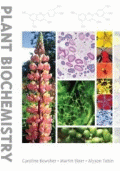|

|
Caroline Bowsher, Martin Steer, Alyson Tobin
Plant Biochemistry
"Plant Biochemistry" is an undergraduate textbook that places biochemistry in the context of the whole plant, from a cellular level to an ecological and environmental level. It is written from the perspective that biochemistry of plants is distinct from that of other organisms for two main reasons: they are autotrophic and sessile. Metabolic pathways are represented as route maps, showing how one reaction follows another, and emphasizing the dynamism and flexibility of plant biochemistry in the face of environmental challenges. The fact that these pathways do not operate in isolation is specifically highlighted throughout, reflected in the coverage of systems-based approaches that provide an understanding of the interlinking processes of biochemical and gene regulation.Photosynthetic, biosynthetic and respiratory pathways and their regulation are covered in detail, emphasizing the influence of the environment e.g. the biosynthesis of alkaloids, phenolics, and terpenoids by which plants produce chemicals to deter herbivores and the complex carbon concentrating pathways of C4 photosynthesis and of Crassulacean Acid Metabolism. Plant cell structure is included, showing how the compartmentalization of many biochemical pathways is used as a regulatory mechanism. The acquisition of the elements and minerals needed for plant growth and development is also covered.The topics covered in "Plant Biochemistry" illustrate that plants and their biochemistry have a direct impact on human activity and success, in terms of their importance as a food supply and as raw materials for industrial and pharmaceutical products. This will be an invaluable text for any second or third year undergraduate student studying plant biochemistry who wishes to understand the relevance of plant biochemistry to plants, humans and animals. It is also an ideal reference text for graduates and researchers.
Garland Publishing; 2008
|



